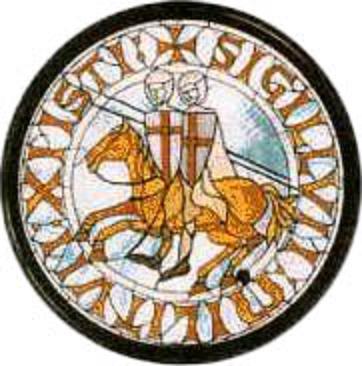giving to thee the mastery of time.
When upon thee death fast approaches,
fear not but know ye are master of Death.”
The Emerald Tablets of Thoth, the Atlantean
The debate about the Knights Templar holding the secrets of the Holy Grail, the Ark of the Covenant, the Philosopher’s Stone and other mystical treasures of antiquity rage on today just as they have continued to catch the imagination of writers, poets and researchers for the past 603 years since the Templars were rounded up on Friday, the 13th of October, 1307 and imprisoned for heresy.
The history of the Templars as recorded does not account for the thousands of Templars who escaped the purge in 1307. They went somewhere and that is where the controversy, speculation and wild imagination came into play. Some said that they quietly disbanded and joined with the remaining chivalric orders of the day such as the Knights of Jerusalem and the Teutonic Knights. Others believe that they took their ships and went to Scotland where they joined up with Robert the Bruce to fight the King of England for Scottish Freedom. Still others believe that they made voyages to the Americas where they buried the Templar treasures at Oak Island in a booby-trapped pit. None or all of these could be true. Certainly there were enough ‘leftover’ members of the Order to undertake a number of enterprises and the records show that they also had the financial means to do whatever they pleased.
I am not a researcher, nor have I ever written a non-fiction work. I am but a poor writer of fiction for the Knights of the Temple. On the other hand, my extensive research into the Knights Templar has taken me to the far reaches of obscurity over the years. I have delved into the history of the Egyptians, the Babylonians, the Sumerians and the Mormons; the Romans, the Greeks and the Celts. I have studied the crusades and the history of Scotland, looked into the mysteries of the Freemasons and plowed through prehistory and speculation regarding Stonehenge, Maes Howe, Ley Lines, the Great Pyramid and the Tomb of the First Emperor of China. My research has crossed the globe from the cliffs overlooking the Aegean Sea to the plains of Nazca overlooking the Pacific Ocean. In my mind, I have traveled the world in search of answers and I believe that I may have found some.
What, you may ask, is the significance of the bit of poetry at the top of the page? That short refrain is but a part of a mysterious book called the Emerald Tablets of Thoth, the Atlantean. The thirteenth chapter is called: the Keys of Life and Death. In this chapter, the author tells of a way of bringing on death whenever the soul is ready for a new body and describes a method for transferring the memories of the current life into the brain of the next physical incarnation, explaining that this is the way of the Great Souls of Old and the Avatars. Many people think this is a book of nonsense. Perhaps it is.
During my studies of the Templars, I learned that they were connected heavily with France and that the first Templars or founding fathers were all French. In France, the Templars made connections with the Cathars, a religious sect in which the leaders were called the Parfaits or the Perfects. These Cathars were seen as a threat to the Catholic Church because it was rumored that they knew something that could potentially damage the Church or that they had great treasures needing to be pillaged for the benefit of the Church. And so, the Pope declared them heretics and set out to rid the world of the Cathars in a crusade known as the Albigensian Crusades that started in 1207, one hundred years before the Templar atrocity and continued on until 1255 when military operations against them ceased. The last burning of a Cathar took place in 1321, seven years after the Templar Grandmaster was roasted in Paris. Strangely enough, the Cathars inhabited the southern part of France known as the Languedoc, the same region of France where the Templars allegedly planned to build their own country.
When the army besieged the Cathar stronghold of Montsegur in 1243, the Cathars there held out for nine months before falling. Just before the castle fell, two or three people allegedly escaped from the castle by scaling a rope down the cliff face and taking with them the Cathar’s greatest secret. Some sources said that these escapees were Templar sympathizers and that the Cathar secret was the Holy Grail or possibly the Ark of the Covenant. Scaling a cliff with the Ark of the Covenant seems unlikely. The Holy Grail? Maybe, if it was indeed a chalice and that is an entirely different can of worms. But more likely, it is possible that it was a precious book or scroll and possibly even something that the Templars had entrusted to the Cathars to keep for them. Possibly something that the original Templar founding fathers had found buried under the ruins of Solomon’s Temple in Jerusalem.
The Cathar’s, it seemed, practiced an odd ceremony or sacrament called the Consolamentum wherein the acolyte apparently gave up everything that might corrupt the body and lived entirely on water and air. Unfortunately, not many of the Cathar Parfaits or Perfect Ones lived very long after partaking of this sacramental ceremony. However! And this is where the above reference to the Emerald Tablets of Thoth, the Atlantean comes into to play, in reading the records of how the crusaders found the Parfaits after the fall of Montsegur and comparing their condition with the writings in chapter 13 of the Emerald Tablets, it seems that the Cathars were practicing Thoth’s Keys of Life and Death. The Parfaits were found lying on their backs in a circle with their heads pointed toward the center, peacefully smiling and utterly dead without the slightest evidence of what might have killed them. The rest of the Cathars were marched out of the castle down the hill to a place where the soldiers had built a roaring bonfire. The Cathars are said to have walked calmly into the fire while singing and died without giving out the least sign of pain or suffering.
Chapter 13 of the Emerald Tablets also refers to passing from this world into death without pain and suffering much as the Cathars did at Montsegur:
“Hear ye, O man, and list to my voice.
List to the wisdom that gives thee of Death.
When at the end of thy work appointed,
thou may desire to pass from this life,
pass to the plane where the Suns of the Morning
live and have being as Children of Light.
Pass without pain and pass without sorrow
into the plane where is eternal Light.”
With these connections in mind, I wrote into my Assassin Chronicles, book number twenty-three (as yet unpublished), the idea that Thoth, the Atlantean was indeed a real entity, an Atlantean Priest King who founded Egyptian civilization after the sinking of Atlantis . And that, even though he lived over 36,000 years ago, he is still alive and waiting for the time when he will be needed again. All we have to do is study his tablets and learn how to call upon him to return from the Halls of Amenti. Yet another mysterious legend tied to the Knights Templar. Obscure, maybe, but great fodder for faith or fiction, your choice.
Kindle Paperback
Brendan will be back Friday with an interview, and on Monday, I will be posting a review of his book Tempo Rubato, the mystery and adventure story of Mozart rescued moments before his inevitable death to be brought to the 1990′s.
Share![]() Tweet This Post
Tweet This Post



